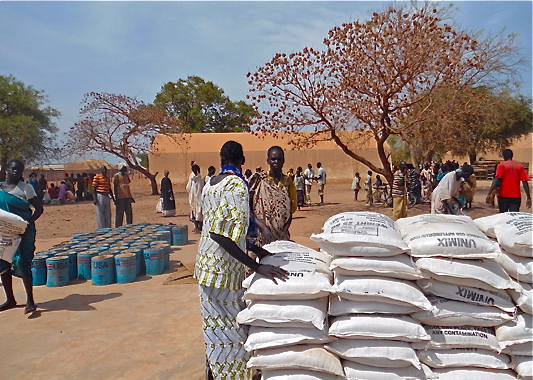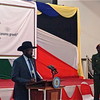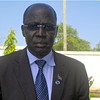Four million South Sudanese face food shortages despite better harvest
The World Food Programme (WFP) and United Nation’s Food and Agriculture Organisation (FAO) warned that more than 4.1 million people are likely to be short of food in South Sudan this year -- affecting approximately four out of every ten South Sudanese citizens.
Their warnings overshadow upbeat pledges by South Sudanese president Salva Kiir who last year told governors that his country will be food secure by 2014 and would supply food to neighbouring nations.
In contrast, the new report on food insecurity said US $354 million was needed to ensure South Sudanese get enough to eat.
 Food Distribution in Warrap State, November 4, 2012.
Food Distribution in Warrap State, November 4, 2012.
Citizens, however, worry that their government will not act in time. It is the work of the government to mobilise funds from the donors,” said John Gatyiel Tut, who lives in the capital Juba. He added that the state government should ensure it can react to emergencies.
Deng Tor Gak, another citizen, described the situation as pathetic” and viewed international NGOs as the only way to prevent people from starving. It will take time for the president’s plan for food security to become reality, he warned.
We are not going to wait for that plan, people will be dying before that is ready,” Kuer Bul Arok, a university student said. I do not know what the ministry of agriculture is doing, they have to provide people with pesticide, tools and some inputs because some people were trying to cultivate last year but their crops were washed away by rain or were attacked by pests.”
The report warned that increased conflict and economic instability could increase the number of people requiring food assistance by more than a million. Violence continues to weigh on South Sudan’s agricultural potential. Farmers’ production is impeded by armed cattle rustling, regional conflicts and militia groups.
The predicted shortages come despite overall agricultural improvement. Food production increased by over 35 percent between 2011 and 2012 due to good rainfall, improved cultivation practices and expanded areas under cultivation.
FOOD SECURITY SNAPSHOT
- 2012 cereal production estimated at above
average levels
- Prices of sorghum and maize, the main
food staples, continue to decline in most
markets
- About 2.9 million people are estimated to
be in need of emergency food assistance in
2013But despite this trend, nearly 40 percent of the country’s population are predicted to have trouble getting enough to eat at some point during the year and more than a million people are expected to be severely food insecure.
However, there is much scope to develop agriculture in the country, according to WFP Country Director Chris Nikoi. South Sudan has tremendous agricultural potential, and the improved harvest estimate is good news, but the country’s overall food security situation remains very precarious. We must redouble efforts to improve the livelihoods of the poorest and most vulnerable South Sudanese, and ensure they can produce their own food or can afford to buy food to meet their needs, and are more resilient to shocks.”
Starvation is a growing problem in the nation which became independent in 2011. Last month at least ten people starved to death in Eastern Equatoria State and many others are struggling to get enough food after widespread crops failure.
The situation is very bad and people are starving: 10 have died in different locations and there is a possibility more could die if there is no rescue,” Eastern Equatoria state Governor Louise Lobong Lojore told Sunday Nation in an interview.
 A plane dropping food aid in Yida, November 15, 2012.
A plane dropping food aid in Yida, November 15, 2012.
South Sudan’s cereal deficit is estimated at 371,000 metric tonnes for the year, which is about one-third of its total cereal requirement of just over one million tons. Commercial imports will meet some of the cereal gap”, but the report notes that because of high food prices and poor commercial supply in some parts of the country, a significant amount of food assistance will be required.
WFP plans to provide food and nutrition assistance to about 2.8 million people, including food insecure rural families, vulnerable children, internally displaced people (IDPs), refugees and returnees. This will require about 224,000 tonnes of food of various kinds.
The Food and Agriculture Organisation leads international efforts to defeat hunger. It helps countries to modernise and improve agriculture, forestry and fisheries practices and ensure good nutrition for all. The FAO focuses on developing rural areas, home to 70 percent of the world’s poor and hungry people.
WFP is the world’s largest humanitarian agency fighting hunger worldwide, feeding an average of more than 90 million people a year, located in more than 70 countries.





